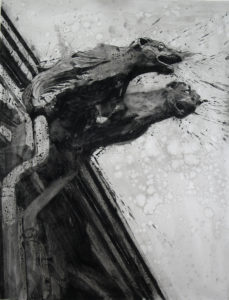
Ephraim and David Dodge Lewis have been invited to show their drawings together at a number of venues, including museums, university art galleries and regional art centers. The exhibition, The Quickening Image: The Wax-Resist Drawings of David Dodge Lewis and Ephraim Rubenstein / A Twenty Year Collaboration, was organized by The Washington County Museum of Fine Arts in Hagerstown, MD. It then traveled to The Longwood Center For The Visual Arts in Farmville, VA, and East Carolina University in Greenville, NC. The exhibition will then travel to the Evansville Museum of Art and Science in Evansville, Indiana, where it will run from December 11, 2016 to February 5, 2017. Subsequently, it will be exhibited at View Art Center in the Summer of 2017.

David and Ephraim have worked together for over twenty years developing a technique for large-scale black and white mixed media drawing called “wax-resist” drawing. It uses wax as a stop-out for subsequent ink and aqua-suspended charcoal washes. The technique is complex and powerful. It utilizes both wet and dry materials; graphite, wax, ink, charcoal, conté, pastel, salt, etc. It has the ability to be used very abstractly with all sorts of wonderful effects, as well as in the service of rendering and creating illusions. All in all, it is an amazing process, very new and little known, and both artists have come up with striking drawings as a result. The word quickening in the title references the sense of life, liveliness, and movement that the process has allowed them to impart to their subjects.
The Quickening Image tells several stories. First, it is the story of a radically new drawing technique: It incorporates both wet and dry materials, as well as both linear and painterly elements. It derives its power from juxtaposing and resolving many contradictory tendencies: drawing/painting; wet/dry; careful/spontaneous; planned/accidental.

The Quickening Image also tells the story of a number of historically marginalized tendencies now given center stage: It is drawing, but on the scale of, and with the impact of, painting; it is grand work, but in black and white rather than in color; it is on paper rather than canvas; and for drawings that are so animated, its subjects are often inanimate objects.
Third, it is the story of a collaboration. David Lewis was aware that the English sculptor Henry Moore used wax as a resist for ink washes in his sketchbooks to quickly develop images at a small scale. David began using paraffin wax himself in large-scale works for exhibition in the mid-1980s. By the early 1990s Lewis was offering workshops in his wax-resist process, including ones at the University of Richmond, where I first observed it. With David’s help, I spent the next twenty years adapting the process to exploit its potential for his own vision.

Finally, it tells the story of a friendship. When artists were members of guilds and often worked collectively, there was a continual transference of information, both technical and aesthetic. Later on, artists became much more isolated, and it became rarer for artists to learn from each other. In order to do so successfully, there has to be a level of mutual trust and respect that is unusual in our time. I have been continually amazed at how open and generous David has always been with his time and knowledge, and I have, in turn, shared this process with my own colleagues and students in New York.
More information about The Quickening Image exhibition, as well as a catalog of images, can be found on its dedicated website.
